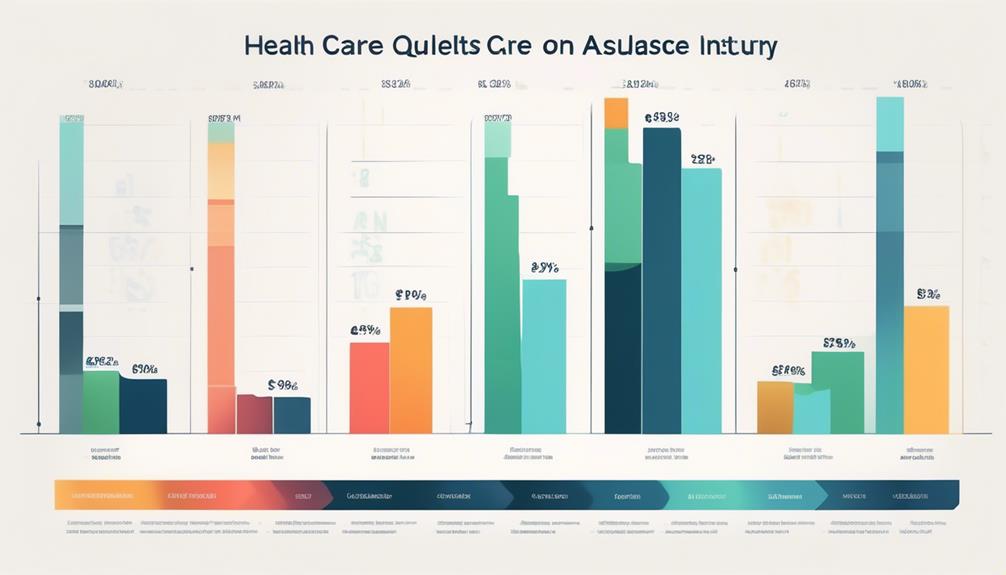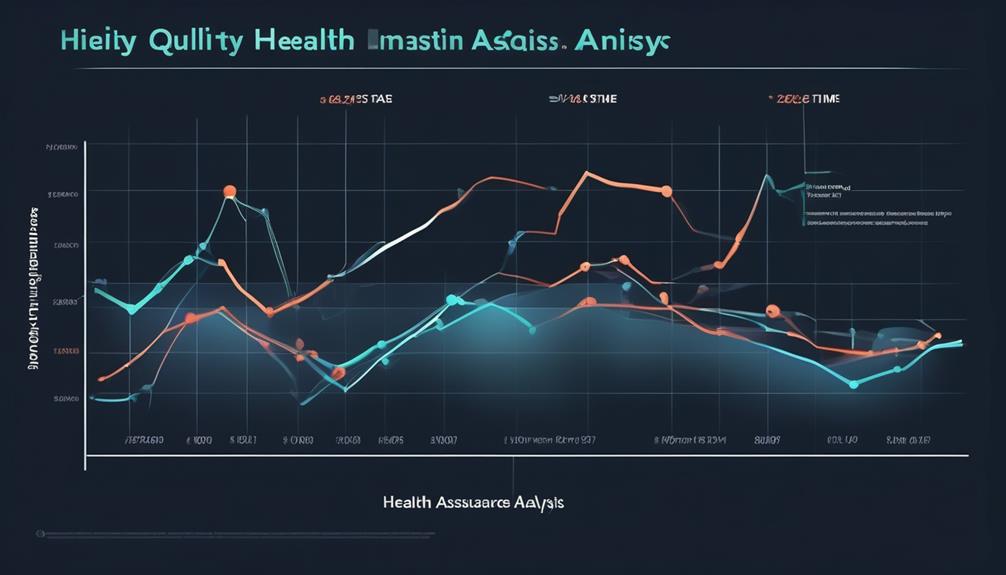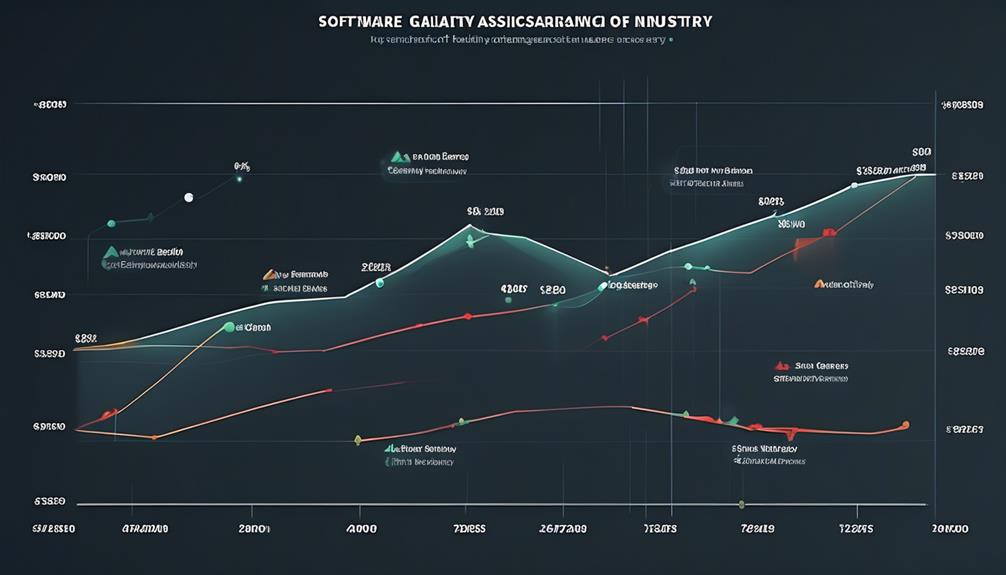In the healthcare sector, the salary of Software Quality Assurance Analysts can be impacted by different factors as the well-known saying goes, “you get what you pay for.”
From the location and size of the company to the level of experience, the numbers can fluctuate significantly. But what exactly determines the salary of a QA Analyst in health care?
Let's explore the various elements that come into play and uncover the average salaries, top-paying companies, and trends in this ever-evolving field.
Key Takeaways
- Experience and seniority significantly influence the salary outlook for QA Analysts in the health care industry.
- Geographic location plays a crucial role in determining the pay scale for QA Analysts in health care.
- Possessing specialized skills and certifications can lead to higher pay for QA Analysts in the health care industry.
- Market demand and competition for talent also impact the salary prospects for QA Analysts in health care.
Factors Affecting Pay Scale
Factors affecting the pay scale for software quality assurance analysts in the healthcare industry include experience, geographic location, company size, specialized skills, and market demand.
Within the healthcare industry, the salary outlook for software quality assurance analysts is influenced by their level of experience and seniority. Those with extensive experience and a proven track record may command higher salaries.
Geographic location also plays a crucial role in determining the pay scale, with certain regions offering higher compensation due to the cost of living and demand for specialized skills.
Moreover, the size and financial stability of the employing company within the healthcare industry impact the pay scale, with larger organizations often offering more competitive salaries.
Additionally, possessing specialized skills and certifications relevant to healthcare-specific quality assurance processes and regulations can lead to increased compensation.
Finally, market demand and competition for talent within the healthcare industry are significant factors, particularly in areas experiencing high growth or innovation in healthcare technology.
Understanding these factors is essential for software quality assurance analysts seeking to maximize their earning potential in one of the highest-paying industries while leveraging their specialization.
Average Salaries in Health Care

On average, software quality assurance analysts in the health care industry earn a salary of $92,629 per year in the United States. This places them among the higher-paying roles within the health care quality analysis field.
However, it's important to note that the average salary for a Healthcare Quality Analyst in the U.S. is $75,870 per year, indicating a variation in pay scales within the health care industry.
When considering a career as a Software Quality Assurance Analyst, it's valuable to assess the potential for higher-than-average salaries. For instance, the top-paying companies for Software Quality Assurance Analysts, such as Apple and Google, offer average salaries of $145,131 and $111,609 per year, respectively.
Moreover, certain states, including Connecticut, New York, and California, provide the highest average salaries for these professionals, ranging from $101,123 to $105,834 annually. This data signifies the variability in pay scales based on factors such as industry, company, and geographical location.
Aspiring professionals in this field should carefully consider these aspects when planning their career paths.
Top-Paying Companies for QA Analysts
Software Quality Assurance Analysts in the health care industry are among the higher-paying roles. When it comes to the top-paying companies for QA Analysts, Apple stands out by offering a median annual salary of $164,655.
Other top-paying companies for QA Analysts include CGI, providing an average salary of $104,092 per year, with a salary range between $89,000 and $122,000.
Additionally, Healthcare Quality Analysts at Mount Auburn Hospital earn an average salary of $71,584 per year, with a salary range between $59,000 and $87,000 annually.
The financial services industry is also noteworthy, offering a median total pay of $110,788 for Software Quality Assurance Analysts, making it one of the top-paying industries for this role.
Moreover, the highest-paying states for Quality Assurance Analysts are California, Washington, and New Hampshire, with average salaries ranging from $81,826 to $83,752 per year.
These insights are valuable for understanding the salary trajectory and career path of QA Analysts, and for identifying the highest paying types and salary ranges in the health care industry.
Pay Trajectory for Health Care QA Analyst

The salary trajectory for Health Care QA Analysts demonstrates a consistent increase with seniority, reflecting higher average earnings for more experienced professionals in this field. As QA Analysts progress in their career path within the health care industry, their pay scale also sees a notable upward trend.
According to available pay data and salary estimates, entry-level QA Analysts in health care command an average annual salary of $90,122. Moving up the career ladder, Senior QA Analysts earn significantly higher, with an average of $121,908 per year. As professionals reach the level of QA Analyst IV, their average annual salary further increases to $124,423 within the health care sector.
The software quality assurance analyst's pay trajectory in the health care industry showcases a rewarding financial progression that aligns with the accumulation of experience and expertise. Moreover, the health care industry stands out as one of the top-paying sectors for software quality assurance analysts in the United States, with a median total pay of $75,870 per year, affirming the industry's commitment to rewarding talent and experience.
Quality Assurance Analyst Salary Trends

Analyzing current salary trends for quality assurance analysts reveals valuable insights into the evolving compensation landscape for professionals in this field. Based on estimates, the average salary for a software quality assurance analyst in the United States is $92,629 annually, with a salary range of $66,000 to $128,000.
The top paying states for quality assurance analysts are New Hampshire, California, and Oregon. Furthermore, the finance industry offers the highest average salary for quality assurance analysts at $116,766, followed by the technology industry at $95,119. Meta and Blackboard stand out as the highest-paying companies for quality assurance analysts, with average salaries of $116,827 and $115,277, respectively.
It's also noteworthy that the highest-paying position types for quality assurance analysts include engineer lead quality assurance lead, senior quality assurance analyst/lead, and senior quality assurance engineer. Understanding these salary trends is crucial for professionals in the health care industry to make informed decisions about their career path, growth and development, and potential relocation to the highest-paying cities.
Frequently Asked Questions
How Much Does a Software Quality Assurance Analyst Make in the Us?
We can find that a software quality assurance analyst's pay in the US averages $92,629 annually, with a range of $66,000 to $128,000.
Top paying companies include Apple, Rambus, AT&T, State Street, and Arrow Electronics.
The highest paying states are New Hampshire, California, Oregon, Connecticut, and Rhode Island.
The finance industry offers the highest average salary at $116,766, followed by the technology industry at $95,119.
What Is the Highest Salary for a Quality Assurance Analyst?
The highest salary for a quality assurance analyst can reach impressive figures, often exceeding six figures in the healthcare industry.
Such lucrative opportunities are typically found in top companies and states known for offering competitive compensation.
These roles command substantial financial rewards, reflecting the critical importance of ensuring quality in healthcare software.
Pursuing this career path can lead to significant financial success, making it a compelling option for professionals seeking substantial compensation.
What Does a QA Analyst Do in Healthcare?
In healthcare, we ensure that software and applications meet regulatory and quality standards. We rigorously test to identify and resolve potential issues, collaborating with developers and healthcare professionals.
We validate updates and new features to uphold patient safety and data accuracy. Due to the critical nature of healthcare technology, we must possess a deep understanding of healthcare regulations and patient privacy laws to effectively assess and improve software quality.
What Is the Highest Salary for a QA Analyst?
We've found that the highest average salary for a QA Analyst is $124,423/yr for the QA Analyst IV position. It's a figure that might make your eyes pop.
Additionally, Apple stands out as one of the top paying companies, offering an average salary of $164,655/yr with 5K open jobs.
The financial services industry is also a lucrative option, with a median total pay of $110,788.
Conclusion
Just as a skilled surgeon carefully ensures the quality of their work in the operating room, a Software Quality Assurance Analyst plays a crucial role in ensuring the quality and reliability of healthcare software systems.
With the potential for a competitive salary and opportunities for growth in this field, it's like a journey through the intricate and vital pathways of the human body, where attention to detail and precision are highly valued.









